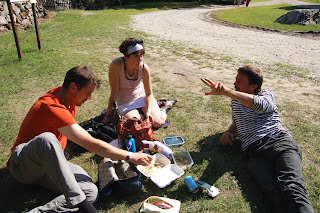Norra reis: villahullusest, liputamisest ja lõngadest. Of wool frenzy, flags and yarn. And sheep, definitely sheep.

Vill A turismiinfopunkti vitriinis
Norwegian sheep wool in a stand in the tourist information center in A


Norrakas on agarad liputajad. Ma mõtlen lippude heiskamist. Iga kord, kui meie buss kuskile kämpingusse jõudis, tõmmati olemasolevatele lisaks masti ka eesti lipp. Loomulikult on põhja pool alati kõrvuti lehvimas Norra ja Saami lipp. See viimane on too hästi kirju, keskel rõngaga. Väljamaa lipud on väljas paljudes kohtades, ja Norra lippudest on eriti uhke Kuningliku Postiteenistuse embleemi kandev puna-sini-valge ja sakkidega. Täiesti juhuslikult avastasin praamil Lofootidelt mandrile, et ka minu džemper sisaldab norra värve. Peale selle olid mul jalas sini-punased šortsid. See vist oli mingi alateadlik impulss. Ja muide, jah, see allolev pilt on monteeritud. Kuramuse lipp oli nii kõrgel et lihtsalt ei mahtunud muidu minuga ühte kaadrisse ära.
Norwegians like flags. The hoist them everywhere. Especially foreign flags, and their own, and sami flags in the north. Every time our bus reached a camping they also hoisted estonian flag in addition to those that were already ther. it indicated who is staying there at the moment. The most vain one of the variations of norwegian flag was the flag for the Roayl Post, with zig-zag at the edge and an emblem. On the ferry from Lofotes to the coast I noticed that I had subconsciously worn norwegian colors - my sweater had blue-red-white stripes and I also had blue-red shorts. What a coincidence, I totally did not have that planned. the flag on the picture below is a montage, well, partly montage, I did not want to torture mom by ordering her to get me and the flag on the same shot.


Peale lippude hoidsin professionaalsest huvist silma peal ka muudel tekstiiliesemetel, nagu saami käsitöö (see mida ei müüdud 100 NOKi eest turismiinfopunktis). Minu suureks rõõmuks või kurvastuseks torkas silma ohtralt vilditud esemeid. Rõõmuks, sest need paistavad olevat populaarsed, kurvastuseks, sest nad oskavaid neid ise piisavalt äste teha et mitte tulla kuskilt lõunamaalt (Eestist) samu asju kokku ostma. Teisalt on vildikultuur igal pool nii erinev et täpselt sarnaseid asju ei tee keegi. Vilditud asjade hinnad aga olid üsna soolased, ühe tillukese 30x40 vaibakese eest küsiti üle 200 NOKi ja sussid maksid 160NOKi.
Besides flags I kept an eye on other textile items out of professional interest. The sami handicrafts (NOT the one they blackmail you several hundreds of NOKs or euros for). To my joy and regret they had a lot of felted items. Joy, cause they seem to love felt, regret, cause they are good enough in making it and probably wouldnt buy a lot of felts from their travels then. But on the other hand the felting traditions are so different everywhere feltmakers arent necessarily such head-on competitors.


Lofootidelt avastasime ka vilditud mütside poekese (tõsi need olid need kootud ja siis vilditud esemed), seal poes käperdasime ka käigu pealt mitmesuguseid norra lambavillast valmistatud lõngu. Hiljem õnnestus käia veel mitmes käsitööpoes uudistamas, kusjuures ühes pidasin müüjaga maha pikema vestluse villast, lõngadest ja traditsioonilistest esemetest. Näiteks lygged...lumes käimise papud, mida lapsed vanasti kandsid. Need on nagu paksendatud tallaga sokid, mille talla vahele topitakse lambavilla. Ja Solvaeris ostsin lõpuks lõnga.... ilusat naturaalset lambavillast, helebeeži halli, punast ja sinist. Värvilised lõngad olid supermarketis odavamadki kui meil, aga mul poleks väga suure hunnikuga midagi peale hakata. ma ei jõua seda ära kasutada. Lõnga ostsin Rootsiski, seal kukkusin aga pisut sisse, pidades 100 g hinda eksikombel kilohinnaks ja maksin 380 g peenvillase lõnga eest üle 30 euro. Noh, hea küll, mis tehtud see tehtud. Ja kahe-kolme salliga teen selle summa ikkagi tasa.
We discovered some craft and yarn shops on the Lofoten and a shop of felted hats ( the knitted-felted etchnique). In one craft shop I held a more serious converastion about some footwear I saw hanging on the wall, she called them "lygge" which is like a snow sock with a three layer footing that has sheep fool inside. She said at old days children wore them when playing outside in the snow. In Solvaer I finally bought some norwegian yarn too, some dark gray, natural beige and blue and red. In the supermarket the yarn seemed to be even cheaper than in Estonia. I also bought yarn in Sweden but I miscalculated the price and ended up spending over 30 euros on just 380 grams of fine woolen yarn. Oh, what the heck, nothing I can do about it. I´ll make it up by selling a few scarves.


Seda ilusat rüiuvaipa nägin kõrgel mäe otsas helesinise fjordi kohal ühes kohvikus. Ega muud polegi öelda. Mingid saamid seal askeldavad. ka veel kaader ülalpool olev tekk või kangas asus samas kohvikus.
This is a nice and rather large tapestry I saw in a cafeteria on top of a mountain. It apparently depicts sami people doing...something.


See gobelään aga kaunistas Borge kirikut.
This tapestry decorated the borge church and functioned as an altharpiece.
Ma oleks võinud veel veeta tunde Tromso muuseumi saamide väljapaneku vöösid, ketrusvahendeid, kostüüme ja punutisi uurides, ent olin niigi teistest maha jäänud. Ja oleks olnud tore osta ka mõni saamide kostüümi põhjalikumalt tutvustav raamat, ent ühe reisi aeg on liiga lühike et kõike korraga tahta.
I could have also spent hours and hours looking at the sami crafts at Tromso museum, all the belts and costumes and weaving techniques, but I had already stayed behind others way too many times because of my peculiar interests. I would also have loved to buy a book on sami costume but one cant ask too much from just a short trip. I guess I will have to keep my eyes open and perhaps try and order something from the internet. Or catch a planeto some city with a huge book store!


Kommentaarid